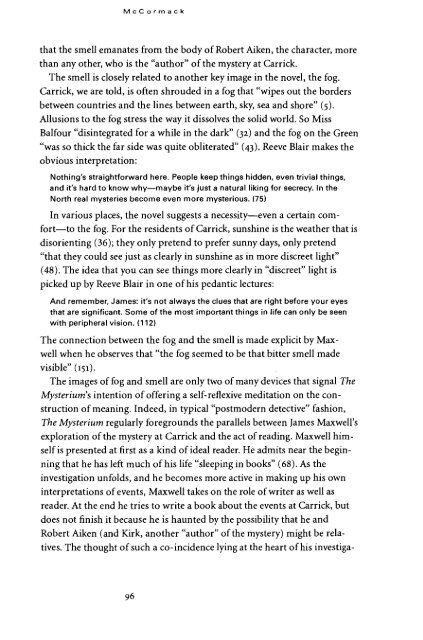A Quarterly of Criticism and Review i^^^^^^^^fcEjfc $15
A Quarterly of Criticism and Review i^^^^^^^^fcEjfc $15
A Quarterly of Criticism and Review i^^^^^^^^fcEjfc $15
You also want an ePaper? Increase the reach of your titles
YUMPU automatically turns print PDFs into web optimized ePapers that Google loves.
McCormackthat the smell emanates from the body <strong>of</strong> Robert Aiken, the character, morethan any other, who is the "author" <strong>of</strong> the mystery at Carrick.The smell is closely related to another key image in the novel, the fog.Carrick, we are told, is <strong>of</strong>ten shrouded in a fog that "wipes out the bordersbetween countries <strong>and</strong> the lines between earth, sky, sea <strong>and</strong> shore" (5).Allusions to the fog stress the way it dissolves the solid world. So MissBalfour "disintegrated for a while in the dark" (32) <strong>and</strong> the fog on the Green"was so thick the far side was quite obliterated" (43). Reeve Blair makes theobvious interpretation:Nothing's straightforward here. People keep things hidden, even trivial things,<strong>and</strong> it's hard to know why—maybe it's just a natural liking for secrecy. In theNorth real mysteries become even more mysterious. (75)In various places, the novel suggests a necessity—even a certain comfort—tothe fog. For the residents <strong>of</strong> Carrick, sunshine is the weather that isdisorienting (36); they only pretend to prefer sunny days, only pretend"that they could see just as clearly in sunshine as in more discreet light"(48). The idea that you can see things more clearly in "discreet" light ispicked up by Reeve Blair in one <strong>of</strong> his pedantic lectures:And remember, James: it's not always the clues that are right before your eyesthat are significant. Some <strong>of</strong> the most important things in life can only be seenwith peripheral vision. (112)The connection between the fog <strong>and</strong> the smell is made explicit by Maxwellwhen he observes that "the fog seemed to be that bitter smell madevisible" (151).The images <strong>of</strong> fog <strong>and</strong> smell are only two <strong>of</strong> many devices that signal TheMysterium's intention <strong>of</strong> <strong>of</strong>fering a self-reflexive meditation on the construction<strong>of</strong> meaning. Indeed, in typical "postmodern detective" fashion,The Mysterium regularly foregrounds the parallels between James Maxwell'sexploration <strong>of</strong> the mystery at Carrick <strong>and</strong> the act <strong>of</strong> reading. Maxwell himselfis presented at first as a kind <strong>of</strong> ideal reader. He admits near the beginningthat he has left much <strong>of</strong> his life "sleeping in books" (68). As theinvestigation unfolds, <strong>and</strong> he becomes more active in making up his owninterpretations <strong>of</strong> events, Maxwell takes on the role <strong>of</strong> writer as well asreader. At the end he tries to write a book about the events at Carrick, butdoes not finish it because he is haunted by the possibility that he <strong>and</strong>Robert Aiken (<strong>and</strong> Kirk, another "author" <strong>of</strong> the mystery) might be relatives.The thought <strong>of</strong> such a co-incidence lying at the heart <strong>of</strong> his investiga-96
















